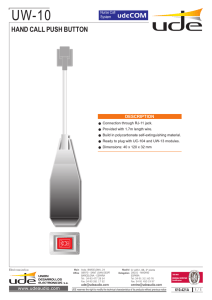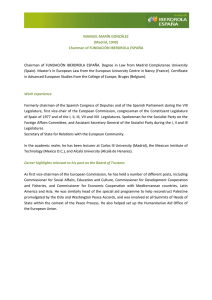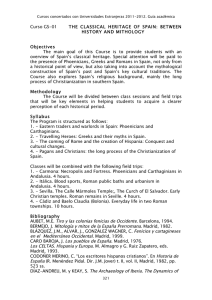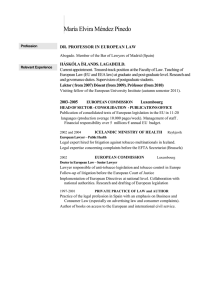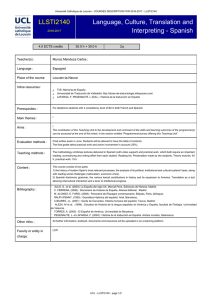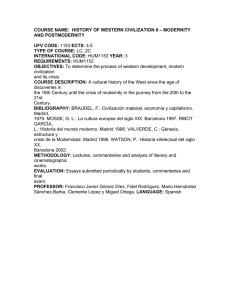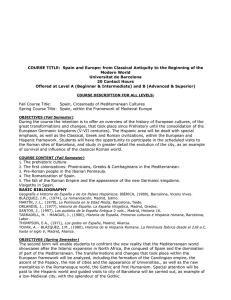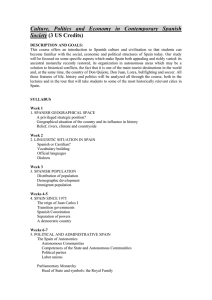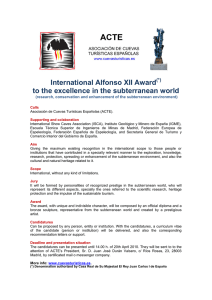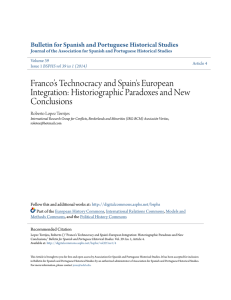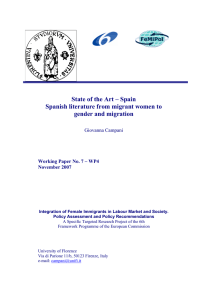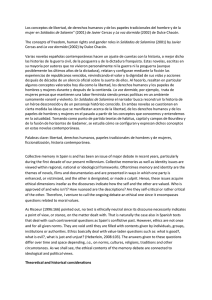DE LA SEGUNDA REPUBLICA A LA MUERTE DE FRANCO
Anuncio
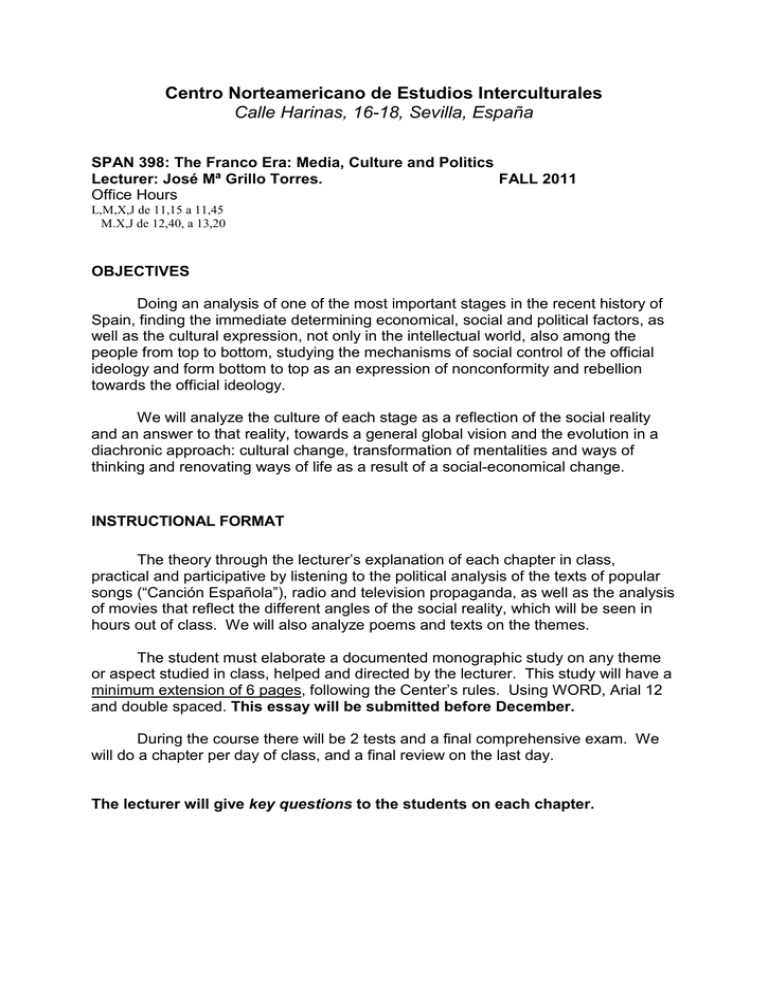
Centro Norteamericano de Estudios Interculturales Calle Harinas, 16-18, Sevilla, España SPAN 398: The Franco Era: Media, Culture and Politics Lecturer: José Mª Grillo Torres. FALL 2011 Office Hours L,M,X,J de 11,15 a 11,45 M.X,J de 12,40, a 13,20 OBJECTIVES Doing an analysis of one of the most important stages in the recent history of Spain, finding the immediate determining economical, social and political factors, as well as the cultural expression, not only in the intellectual world, also among the people from top to bottom, studying the mechanisms of social control of the official ideology and form bottom to top as an expression of nonconformity and rebellion towards the official ideology. We will analyze the culture of each stage as a reflection of the social reality and an answer to that reality, towards a general global vision and the evolution in a diachronic approach: cultural change, transformation of mentalities and ways of thinking and renovating ways of life as a result of a social-economical change. INSTRUCTIONAL FORMAT The theory through the lecturer’s explanation of each chapter in class, practical and participative by listening to the political analysis of the texts of popular songs (“Canción Española”), radio and television propaganda, as well as the analysis of movies that reflect the different angles of the social reality, which will be seen in hours out of class. We will also analyze poems and texts on the themes. The student must elaborate a documented monographic study on any theme or aspect studied in class, helped and directed by the lecturer. This study will have a minimum extension of 6 pages, following the Center’s rules. Using WORD, Arial 12 and double spaced. This essay will be submitted before December. During the course there will be 2 tests and a final comprehensive exam. We will do a chapter per day of class, and a final review on the last day. The lecturer will give key questions to the students on each chapter. FORM OF ASSESMENT Participation.................................25% Tests ...........................................25% Essay………………......................25% Final Exam...................................25% STUDENT BOOK José Mª Grillo Torres. Historia social del franquismo. Sevilla, 2010. ADDITIONAL BIBLIOGRAPHY Anónimo. El niño bien educado. Madrid: Bruño, 1952. Brenan,G. El laberinto español. París: Ruedo Ibérico, 1978. Carr, R. España. Barcelona: Ariel, 1992. De Miguel. 40 millones de españoles 40 años después. Madrid: Planeta, 1978. Gallego. España siglo XX. Madrid: ED actas, 2005. García Nieto. La España de Franco. Madrid: Tecnos, 1998. Harrison. Historia económica de la España contemporánea. Barcelona: Vives, 2001. Hombravella. Capitalismo español. Madrid: CpD, 1977. Lacomba. Historia social de España. Siglo XX. Madrid: Guadiana, 1998. Lopera, A. La escuela Nacionalcatólica. Madrid: Crítica, 2004. Preston, P. España en crisis. Madrid: FCE, 1987. Preston, P. Franco. Madrid: Grijalbo, 2002. Tamales. La República. La era de Franco. Madrid: Alianza, 1989. Thomas, H. La guerra civil española. (Dos tomos) Madrid: Crítica, 2004. Tussell, J. Franco: una biografía. Madrid: Crítica, 2002. . SUBJECT INDEX First Part: Towards the Republic Chapter 1.Economic structure and society of Spain in the beginning of the 20 Century. The process of the social “spin”. The creation of the two Spain. The right. The left. The weakness of the center as a consequence of the weakness of the middle classes. Chapter 2.The arrival of the Republic. The new political system: the Constitution of 1931. The political reforms of the 2nd Republic and its consequences. The three enemies of the System. The effects of the crisis in the 30. Europe between Fascism and revolution. Chapter 3.Mythologies and esthetics of the both the right and left. The people. The oligarchy. The symbols of the left and the right: colors, hymns, salutations, flags... The order, the tradition, the imperial past, family, religion... The anarchy, spontaneity, the future, the new, “children yes, husbands no”... Chapter 4.Elections of 36: towards a civil war: Mola, Queipo, Franco. The left’s dilemma: save the Republic or create a revolution. From the political fight to the fight to death. From expressions such as “¡arriba España!“ to “¡No pasarán!” The society at war. Daily life in both the National and Republican sides. Culture and propaganda. Cara al sol, El novio de la muerte, la Internacional. International aid. Chapter 5.Songs for a war. The Republic area: Lorca and la Argentinita, Miguel de Molina, the songs from the front and the rearguard. Poetry from the left: Neruda, Alberti, Nicolás Guillén, Hernández, A. Machado. The National area: Celia Gámez, Estrellita Castro, Imperio Argentina. Extending the war and the reasons of both Franco and Negrín. 2ª Parte: Franco’s Triumph Chapter 6.The political system. Social bases of the regime. Falange, the Church and social control. The psychological and social impact of the end of the war. Peace or Victory. Winners and losers. The role of the Church and of Falange. Coercion and Persuasion. Social control and repression. From the culture of misery to the misery of culture Propaganda: el NODO. Chapter 7.Spain and World War II. Franco’s positions: from neutrality to the non-belligerent. The Blue Division. The pro-Germans and the pro-Allies. Cultural Germanization of Spain during the period. The Allies victory and its consequences for Spain. The Spanish folk song: Concha Piquer, Antonio Molina. Chapter 8.Songs after the war. The isolation and autarchy period. The “caudillo’s” maquivelism: creating from the inevitable isolation a necessary prophylaxis. The economic disaster, the rationing of food, a dish a day. The black market. "La colmena" Radio serials. The radio and publicity. El Cola Cao, La gallina Turuleta, La vaca lechera... Chapter 9.The official Spain and the real Spain. A critical vision through the movies, despite censorship, “Bienvenido Mr. Marshall” by Berlanga. “Calle Mayor” by Bardem. “Viridiana” by Buñuel. The use of flamenco as a stereotype. M. Caracol y A. Mairena. The folklorists. Lola Flores. Chapter 10.From the Stabilization Plan to development. Two parallel phenomena: emigration and tourism. The popular myths of Spain’s sixties. The “ye-ye” phenomena. The macho ibérico, la española cuando besa... The misery of the official culture: M.Escobar, Raphael y Massiel. The world of Juan Marsé: Las aventis, el pijoaparte, Teresa. Chapter 11.The counterculture arrives in Spain. Resistance to the system. The labor movement. The University moves. Reflection of the repression in the popular culture. Recovering Marxism. The myth of the revolution. La Nova Canço, los “novísimos”. The compromised songs: Raimon, Paco Ibáñez, Lluis Llach, Aute, Serrat. Conclusion: And after Franco, ¿what happens? Chapter 12.The Transition’s dilemma. Suarez between two fronts: the economical crisis and the political crisis. The Constitution of 1978 and the parliamentary monarchy. Overcoming the problems. “La Movida” (the Movement). Almodóvar. The evasion: from the sixties idealism to the nineties pragmatism.
